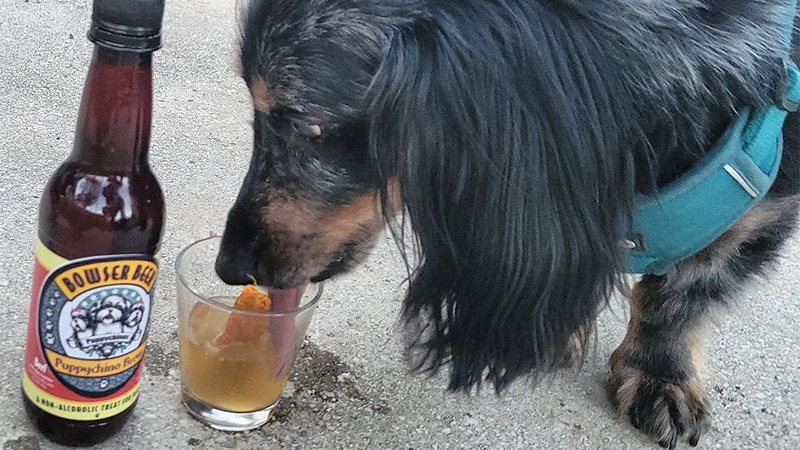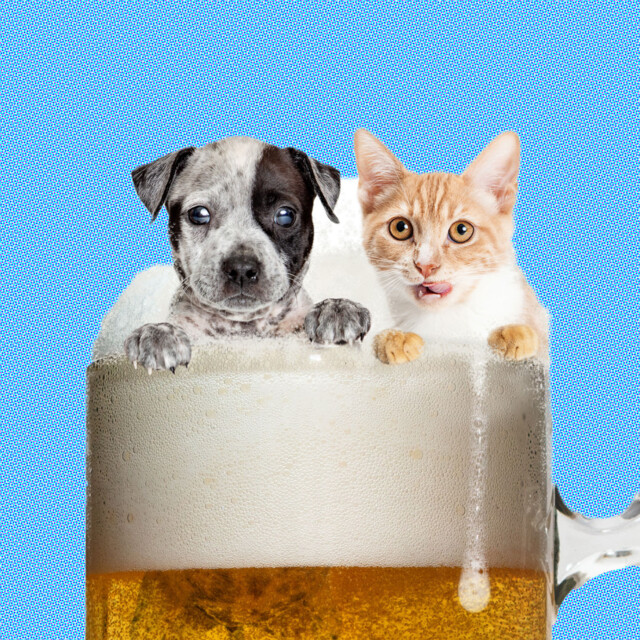Funny or otherwise, the holidays always bring out plenty of marketing stunts, and 2022 is no exception. Along with the special bottles for sharing with friends and family at the Thanksgiving table this year, many of those celebrating will also pour a special beverage for their furry friends — or at least that’s what Anheuser-Busch InBev hopes. This year, the world’s largest beer company is offering Busch Turkey Broth Dog Brew, its second mass-market beer for dogs since its original pork-flavored dog beer hit the market in 2020.
Available in canned 4-packs, Busch’s Thanksgiving-themed dog drink is a non-alcoholic brew made from vegetables, herbs, spices, and turkey broth. For a company that sold over 495 million barrels of beer in more than 150 countries last year, it can’t amount to much more than a bit of marketing. As Busch reported, its 2020 beer for dogs sold out within 24 hours, which would be hard to imagine as a meaningful effect on the bottom line.
It does, however, point to an interesting phenomenon: More and more, those who like to drink like drinking with their pets. From Belgium to Brazil, beers for dogs keep hitting the market, though some of the largest brands have been around for more than a decade. Many pubs, bars, and restaurants now offer doggie menus of canine drinks and treats. Dog-focused bars — like the Omaha Dog Bar in Nebraska and Club K-9 in Louisville, Ky. — can be found all over.
But pouring a beer for your dog isn’t the same as sharing a beer with another human: Alcohol is toxic for pets, and hops, a principal ingredient in most beers, are additionally dangerous for dogs. More to the point: Even the most amazing dogs can’t actually raise a glass, and most of them probably can’t say cheers.
So why is this happening, exactly?
Dog Beer Sells Out
When she first came up with the idea for her best-selling beer for dogs back in 2008, Jenny Brown was actually trying to sell pretzels for people.

“It was just kind of a fluke. I was actually at a farmer’s market and everybody kept saying, ‘Well, I need something for my dog. I need to take something to somebody’s house, and if I take something for the dog, I’ve got it covered,’” she says. “So I converted it into a pretzel treat for dogs. And then I thought, well, what goes with pretzels but beer?”
Aided by her daughter, Jess Arnett, Brown cooked up an initial batch of Bowser Beer in her home kitchen. When the two took that beer to a local pet festival, it quickly sold out.
“From the feedback I got I just naively thought, Oh, this is something we could turn into a business,” she says with a laugh. “And it just snowballed.”
It might not get as much attention as a supermarket brand like Busch, but Seattle’s Bowser Beer is a success by any measure: It’s now sold at more than 500 locations across the U.S., and unlike Busch’s marketing-focused holiday dog brew, Bowser is available year-round.
Brown did have at least one competitor back in the early days, she recalls, but that product eventually left the market.
“So we continued on and for a long time, many years, we didn’t have any competition,” she says.
That might have been true for a while. But in the years since, a number of other dog beer brands have popped up. In Montreal, there’s Brouff Bière pour Chien. In Texas, Good Boy Dog Beer says it sells its Crotch Sniffin’ Ale, IPA Lot in the Yard, and other beers for dogs in some 200 locations in 39 states.
Rest assured, the “drinks for pets” trend goes well beyond beer and dogs. (Fair warning: The puns don’t get any better.) Pet Winery offers its catnip-flavored Mëow & Chandon and Purrgundy wines for cats, as well as a “dog Champagne” called Dög Pawrignon. Apollo Peak lists Pinot Meow and White Kittendel among its feline wines, alongside its Zinfantail and Chardognay wines for dogs.
It’s the result of what Arnett calls a burgeoning market.
“Pet ownership, particularly during the pandemic, has been on an upward trend for the last 10 to 15 years. So has pet spending,” she says. “The swath of customers is really wide. We sell to home improvement stores, we sell to pet stores. We sell to retail stores, we sell to bars and restaurants.”
The Doggie Menu
Pouring a turkey-flavored beer for your dog or catnip wine for your cat at home is one thing, but taking your pet out for a drink is something else. By any indication, that’s also a growing global trend. Dog-friendly “puppy menus,” like the one Chicago’s Nonnina created last year, are commonplace. Just last month, the Bundobust craft beer chain in the U.K. launched its own doggie treats, while in Texas, the Houston Chronicle wrote about the best local bars and restaurants for dog owners.
That’s actually a big part of drinks for pets, because for good or bad, those drinks — made with beef or poultry broth, salmon oil, or other food-based flavorings — are often more like foods than beverages.
A professor of psychology at I.U. Internationale Hochschule in Bad Reichenhall, Germany, Andrea Beetz studies human-pet interactions. She believes that much of the motivation for drinking with pets comes from anthropomorphism, when we attribute human characteristics to something that is not human.
“I think it comes down to anthropomorphizing, and it’s not as bad as it sounds,” she says. “In biology, anthropomorphizing actually just means that you take your own ways of understanding things and apply them. And there’s no other way of doing it, because you only have your brain. You don’t know how a pigeon thinks or how a cat thinks.”
In fact, humans can do a pretty good job of estimating how many animals think, she says, because humans and social mammals share the same brain structures and social mechanisms. Our biology also inspires us to want to take care of pets.

“To provide successful caregiving to another human, to another animal, that actually releases hormones that make you feel good,” she says. A scientific paper she co-authored studied the role of oxytocin, sometimes called “the love hormone,” in human-animal interactions.
Such feel-good motivators might make us think that our pets prefer treats, but that’s not necessarily the case.
“It’s actually just for the human,” she says. “We think that things that we like, the dog or the cat likes, since we consider them family members or buddies,” she says. While that can be true in some cases, it can also lead to misconceptions. In other words, just because we want to eat pasta, it doesn’t mean our dogs want to eat pasta, too.
While there’s no harm in offering a pet a treat, she says, there are many other ways to show our pets you love them, like playing fetch or taking them for a walk.
“I personally enjoy much more when the person joins the animal in a natural interaction that is really fun for the animal,” she says. “But all the feeding, that’s also why we have an obesity problem in pets. And most of our pets are overweight today.”
A board-certified cardiologist and the director of the Feline Health Center at Cornell University College of Veterinary Medicine, Bruce Kornreich has a similar take on pet beverages. While he is not aware of any research suggesting that catnip-based wines for cats might be problematic for a cat’s health, he says there’s nothing like spending quality time with your pet.
“Dedicated play time, dedicated exercise time, walking,” he says. “I’m talking mostly about cats. If you really want to bond with your cat, spend 10 minutes playing with them. If you really want to bond with your cat, do some clicker training.”
In some cases, the food-based nature of drinks for pets can be a plus. Pet foods and snacks are regulated by the FDA, Brown and Arnett say, adding that some of their customers buy Bowser Beer for their older dogs who have lost their appetites, using it to wet their kibble and inspire them to eat. Similarly, some hotels stock Bowser Beer in order to help dogs find their appetite when they’re stressed out by travel. When it comes to catnip wines, Kornreich notes that not all cats respond to catnip. For those that do, veterinarian Heather Hoffmann writes that catnip can reduce anxiety, relieve pain, and help with separation anxiety.
Beyond the possible practical uses, Arnett believes that pet drinks are simply just about humans and animals doing something together.
“People like to share experiences with their pets,” she says. “And one experience that I think a lot of people share is that they enjoy sharing a beer.”
But even after 14 years, the appeal of beer for dogs is still a bit of a mystery for Brown.
“When you’re talking about the ‘why,’ I have questioned this many times over the years,” she says. “I’ve seen so many dog fads come and go. And it just resonates and it stayed. If anything, it’s gotten more popular.”
